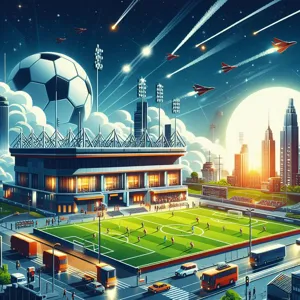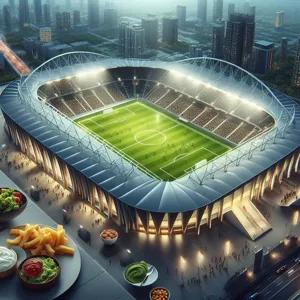Football stadiums are more than just venues; they are the beating heart of the game, where architecture and atmosphere converge to create an unparalleled experience for fans and players alike.
From the soaring stands that amplify the roar of the crowd to the intricate design elements that enhance visibility and accessibility, every aspect of a stadium is meticulously crafted to elevate the excitement of the game. As we delve into the world of football stadium design, we’ll explore how features like seating arrangements, acoustics, and even the choice of materials influence not just the aesthetic appeal but also the overall experience of attending a live match. Join us on this journey as we uncover the fascinating relationship between stadium architecture and the thrilling emotions that football ignites, revealing how these iconic structures shape the very essence of the beautiful game.
1. Introduction to Football Stadium Design

Football stadium design is a fascinating interplay of architecture, engineering, and fan experience, shaping not only the aesthetic appeal of the venue but also the very essence of the game itself. As the heart of any football match, the stadium serves as a sacred space where fans converge, emotions run high, and unforgettable memories are created. From the grandeur of iconic structures like Camp Nou and Wembley to the intimate charm of local grounds, each stadium tells a unique story through its design.
Modern stadiums are meticulously crafted with an emphasis on enhancing the spectator experience. Key elements include sightlines, acoustics, and seating arrangements, all of which contribute to how fans perceive the game. An optimal design ensures that every seat offers a clear view of the pitch, while innovative materials and technologies amplify the sounds of the crowd, creating an electric atmosphere that elevates the excitement of the match.
Moreover, the design of football stadiums is increasingly focused on sustainability and community integration. Many new stadiums incorporate green technologies, energy-efficient systems, and multifunctional spaces that serve the local community beyond match days. This evolution reflects a broader understanding of the role these venues play, not just as places to watch football but as vital hubs for social interaction and cultural exchange.
In this exploration of football stadium design, we will delve into the various architectural styles, the impact of modern technology, and how these elements converge to shape the overall game experience for players and fans alike. Join us as we kick off this journey into the world of football stadiums, where design meets passion and the beautiful game comes to life.
2. The Evolution of Stadium Architecture
The evolution of stadium architecture is a fascinating journey that mirrors the development of football itself, revealing how design influences not only the aesthetic appeal of a venue but also the overall game experience for fans and players alike. From the ancient amphitheaters of Rome to the modern-day cathedrals of sport, stadiums have transformed dramatically over the centuries, adapting to changing technologies, cultural norms, and spectator expectations.
In the early days, stadiums were often simple, open-air structures that prioritized functionality over form. With wooden benches and basic amenities, the focus was on providing a space where fans could gather to watch the game, with little thought given to comfort or viewing angles. However, as football grew in popularity and the crowds swelled, the need for more sophisticated designs became apparent. Architects began experimenting with new materials and layouts, leading to the construction of iconic stadiums that would redefine the spectator experience.
The introduction of cantilevered roofs in the mid-20th century marked a significant milestone in stadium design. These roofs not only provided shelter from the elements but also enhanced acoustics, amplifying the roar of the crowd and creating an electrifying atmosphere during matches. This innovation was complemented by advancements in seating arrangements, which prioritized sightlines and comfort, ensuring that every fan had a prime view of the action.
As technology continued to evolve, so too did the ambitions of stadium architects. The rise of digital displays, sophisticated lighting systems, and integrated sound systems transformed stadiums into multi-sensory experiences. Modern venues like the Allianz Arena in Munich and the Tottenham Hotspur Stadium in London showcase cutting-edge design, featuring retractable roofs, modular seating, and state-of-the-art amenities that cater to the needs of today’s fans. These innovations not only enhance the matchday experience but also allow stadiums to host a variety of events, from concerts to community gatherings, ensuring their relevance in a rapidly changing world.
Ultimately, the evolution of stadium architecture reflects a broader understanding of the importance of design in shaping the game experience. As we look to the future, the challenge for architects will be to create spaces that are not only visually stunning but also environmentally sustainable and deeply connected to the communities they serve. By blending tradition with innovation, the stadiums of tomorrow promise to elevate the beautiful game to even greater heights, ensuring that every match is a memorable experience for all who attend.
3. Key Elements of Stadium Design

When it comes to football stadium design, several key elements work in harmony to create an unforgettable game experience for fans, players, and officials alike. Each aspect of the design serves a purpose that goes beyond aesthetics, influencing everything from crowd engagement to player performance.
**Seating Arrangement**
The arrangement of seats is one of the most crucial elements in stadium design. A well-designed seating layout ensures that every fan has a good view of the action on the field. Modern stadiums often feature tiered seating, which not only enhances sightlines but also amplifies the crowd’s energy, creating an electric atmosphere. Additionally, the proximity of the seats to the pitch allows fans to feel intimately connected to the game, heightening their emotional investment.
**Acoustics**
Sound plays a vital role in the stadium experience. Designers consider acoustics carefully, ensuring that the cheers and chants of the crowd echo powerfully throughout the venue. Unique architectural features, such as domed roofs or strategically placed barriers, can trap sound and amplify the roar of the fans, creating an intimidating environment for opposing teams and an exhilarating one for home supporters.
**Lighting**
Lighting design in stadiums goes beyond mere visibility; it sets the mood and enhances the overall spectacle of the game. Dynamic lighting systems can highlight key moments—such as player introductions or goals—while also providing adequate illumination for nighttime events. Furthermore, LED technology allows for creative light shows that can captivate the audience, making each match a multi-sensory experience.
**Concessions and Amenities**
A successful stadium isn’t just about the game; it’s also about the overall experience. Thoughtfully designed concessions and amenities play a significant role in keeping fans happy and engaged. Ample food and beverage options, clean restrooms, and comfortable lounges or gathering areas enhance the enjoyment of the game. In addition, technology-infused amenities such as mobile ordering and cashless payment systems streamline the process, allowing fans to spend more time cheering for their team rather than waiting in lines.
**Accessibility**
Finally, a key component of modern stadium design is accessibility. Ensuring that all fans, regardless of their physical abilities, can enjoy the game is paramount. This includes features such as wheelchair-accessible seating, ramps, and restrooms, as well as clear signage that guides patrons throughout the venue. A commitment to inclusivity not only broadens the audience but also fosters a welcoming community spirit.
In summary, the design of a football stadium encompasses a myriad of elements that work together to shape the game experience. From the seating arrangements that bring fans closer to the action, to the acoustics that amplify their energy, each aspect is intricately woven into the fabric of the venue. As stadiums continue to evolve, the focus remains on creating an immersive experience that captivates all who enter.
4. The Role of Seating and Sightlines
The seating and sightlines in a football stadium play a pivotal role in shaping the overall game experience for fans. Imagine stepping into a stadium where every seat is designed to immerse you in the action, where the thrill of a last-minute goal can be felt not just in the stands, but reverberates through the very structure around you. Thoughtful seating arrangements can enhance the atmosphere, fostering a sense of community and excitement that elevates the match-day experience.
The design of seating is not merely about aesthetics; it’s a carefully calibrated balance of comfort and visibility. Stadiums are increasingly incorporating wider seats with ample legroom, ensuring that fans can enjoy the game without feeling cramped. However, comfort must go hand-in-hand with sightlines. Optimal sightlines ensure that every spectator, regardless of their location within the stadium, has an unobstructed view of the pitch. This is particularly crucial in a sport like football, where the dynamics of play can shift in an instant.
Innovative stadium designs often feature tiered seating arrangements that rise steeply, allowing fans in the upper levels to have a clear view of the field. This vertical design not only enhances sightlines but also amplifies crowd noise, creating an electrifying atmosphere that can intimidate opposing teams. In contrast, a flat seating arrangement can lead to obstructed views and a less engaging experience, diminishing the impact of the game.
Moreover, the integration of modern technology, such as large video screens and augmented reality displays, can further enhance the spectator experience. These elements not only keep fans informed about the game but also provide instant replays and statistics, making every seat feel like the best seat in the house.
In essence, the role of seating and sightlines in football stadium design is crucial. It shapes not only how fans perceive the game but also how they connect with one another and with the team. A well-designed stadium transforms a simple match into a shared spectacle, where every cheer, every gasp, and every moment of tension is felt collectively, creating lasting memories for fans that go beyond the scoreline.
5. How Stadium Layout Influences Fan Engagement

The layout of a football stadium plays a pivotal role in shaping the overall game experience for fans. From the moment spectators step through the gates, the design elements influence how they connect with the action unfolding on the field. A well-thought-out stadium layout enhances visibility, fosters excitement, and creates an atmosphere that resonates with the energy of the game.
Consider the configuration of seating: stadiums with steeply tiered stands allow fans to feel closer to the pitch, amplifying their emotional investment in the match. This vertical design not only improves sightlines but also creates an intimate setting where cheers and chants can echo more powerfully, transforming individual voices into a unified roar. In contrast, stadiums with flatter layouts may distance fans from the on-field action, diminishing the intensity of the experience and leading to a less engaged crowd.
Moreover, the arrangement of amenities—like concession stands, restrooms, and merchandise shops—can significantly affect fan engagement. Smartly placed facilities encourage fans to mingle during halftime, fostering a sense of community and shared excitement. If these areas are easily accessible and well-integrated into the stadium design, they can enhance the overall enjoyment of the game, allowing fans to savor every moment without missing out on the action.
Stadium design also encompasses the use of technology, such as large video screens and sound systems. Strategically positioned displays not only provide real-time updates and replays but also help amplify the collective energy of the crowd. When fans can easily see and hear the game from every corner of the stadium, it deepens their connection to the event and enhances their overall experience.
Ultimately, the layout of a football stadium is not just a matter of aesthetics; it directly influences fan engagement and the way spectators experience the thrill of the game. A thoughtfully designed stadium invites fans to immerse themselves in the atmosphere, creating lasting memories that keep them coming back for more. Whether it’s the buzz of excitement as the players take the field or the electric anticipation of a last-minute goal, the right layout can transform a simple match into an unforgettable event.
6. The Importance of Atmosphere and Acoustics
When it comes to football stadiums, the magic often lies not just in the game itself, but in the atmosphere that envelops it. The design of a stadium plays a pivotal role in shaping this experience, with acoustics being a significant contributor. Imagine walking into a stadium just before kickoff—the roar of the crowd, the rhythmic chant of fans, and the palpable energy in the air all come together to create an unforgettable ambiance.
Stadiums are meticulously designed to amplify these sounds, using structural elements like bowl shapes and sound-absorbing materials to enhance the auditory experience. The steepness of the stands can direct cheers and chants down toward the field, creating a thunderous echo that resonates throughout the venue. This not only boosts player morale but also intimidates opposing teams, turning the stadium into a fortress of home-field advantage.
Moreover, thoughtful placement of the crowd in relation to the pitch can elevate the intensity of the experience. For instance, closer seating arrangements allow fans to feel intimately connected to the action, while strategically positioned standing areas can ignite spontaneous celebrations, forging a collective energy that binds everyone together.
The atmosphere is further enriched by the stadium’s design elements—lighting, color schemes, and even the choice of materials can evoke emotions and enhance the overall aesthetic. When fans enter a stadium that resonates with their club’s identity, they are more likely to feel a deeper connection to the team, resulting in a more immersive experience that goes beyond the game itself.
In essence, the importance of atmosphere and acoustics in football stadium design cannot be overstated; they transform a simple match into a captivating spectacle that resonates long after the final whistle blows.
7. Case Study: Iconic Stadiums Around the World

When it comes to football stadiums, few can match the grandeur and historical significance of iconic venues around the world. Each stadium tells its own unique story through its design, structure, and atmosphere, profoundly shaping the game experience for players and fans alike.
Take the legendary Camp Nou in Barcelona, for instance. With a capacity of nearly 100,000, it stands as one of the largest stadiums in the world. The design maximizes sightlines, ensuring that every fan, regardless of their seat, feels close to the action. The steeply raked stands create an electrifying environment that amplifies the roar of the crowd, giving players an unmatched sense of support and intensity. The blend of modern amenities with the club’s rich history makes Camp Nou not just a stadium, but a pilgrimage site for football lovers.
Across the Atlantic, we find the iconic Maracanã Stadium in Rio de Janeiro. Renowned for its stunning architecture and vibrant atmosphere, the Maracanã has hosted two FIFA World Cup finals. Its circular design and open-air structure allow for breathtaking views of the surrounding landscape, creating a unique connection between the stadium and the city. The acoustics are remarkable, capturing the passion of the Brazilian fans, allowing their chants and cheers to reverberate throughout the venue, creating an electrifying atmosphere that can give players chills.
Closer to home, the historic Wembley Stadium in London stands as a testament to the evolution of football architecture. With its iconic arch and capacity of 90,000, Wembley is not just a stadium but a symbol of English football. Its cutting-edge design incorporates advanced technology that enhances the fan experience, from high-definition screens to comfortable seating. The stadium’s ability to host a variety of events, including concerts and sports beyond football, speaks to its versatility and importance as a cultural hub.
These iconic stadiums exemplify how thoughtful design can elevate the game experience, creating an enduring bond between the players, the fans, and the very fabric of football culture. They remind us that behind every memorable match lies a stadium that not only houses the game but also amplifies its emotions, celebrates its history, and fosters an unbreakable sense of community among supporters worldwide. As we explore the design elements that shape these venues, we come to understand that each stadium is a character in the narrative of the beautiful game.
8. The Impact of Technology in Modern Stadiums
In today’s fast-paced digital world, technology plays a pivotal role in enhancing the overall experience within modern football stadiums. Gone are the days when fans had to rely solely on the action unfolding on the pitch; now, they can immerse themselves in a fully integrated environment that combines live gameplay with cutting-edge technological advancements.
One of the most significant innovations is the implementation of high-definition video screens and immersive sound systems, which elevate the game experience to unparalleled heights. These enormous display boards, strategically positioned throughout the stadium, ensure that every spectator, regardless of their seat location, has a clear view of the action. Instant replays and multiple camera angles keep fans engaged even during brief pauses in play, allowing them to relive pivotal moments as they happen.
Moreover, modern stadiums harness the power of mobile technology to foster engagement and convenience. Dedicated apps enable fans to navigate the stadium, order food and beverages without missing a moment of the game, and even access real-time statistics and player information—all from the palm of their hand. This level of accessibility not only enhances fan satisfaction but also encourages them to stay connected with the game on a deeper level.
Wi-Fi connectivity has also transformed the way fans interact with each other and the game. Social media walls displaying live tweets and posts allow supporters to share their thoughts and reactions, creating a communal atmosphere that transcends physical boundaries. As fans tweet, post, and share their experiences in real-time, they contribute to a vibrant online presence that amplifies the excitement of the match day.
Additionally, technology is revolutionizing the way stadiums are designed. From smart lighting systems that adjust according to gameplay to energy-efficient materials that reduce the environmental impact, architects and planners are embracing innovative solutions to create multifunctional spaces. Many modern stadiums are equipped with retractable roofs and modular seating arrangements, allowing for a versatile venue that can host a variety of events beyond football matches.
In essence, the integration of technology in modern football stadiums is not merely a trend; it’s a fundamental shift that shapes the game experience in profound ways. By enhancing fan engagement, improving convenience, and adapting to the evolving needs of spectators, stadiums are transforming into immersive entertainment hubs that redefine how we experience the beautiful game. As technology continues to advance, we can only anticipate even greater innovations that will shape the future of football stadium design and the experiences they offer.
9. Sustainable Design Practices in Stadium Architecture
In recent years, the conversation surrounding sustainable design practices has gained momentum across various industries, and the world of stadium architecture is no exception. As the environmental impact of large-scale constructions comes under scrutiny, architects and designers are increasingly turning to eco-friendly strategies to create stadiums that not only house exhilarating sporting events but also promote sustainability and reduce carbon footprints.
Imagine walking into a stadium that seamlessly integrates natural elements with cutting-edge technology. Many modern stadiums are now incorporating green roofs, which not only provide insulation but also serve as urban gardens, helping to absorb rainwater and support local biodiversity. These living roofs create a unique visual appeal and enhance the overall atmosphere, reminding fans of the connection between the game and the natural world.
Furthermore, energy-efficient systems are becoming a staple in stadium design. From solar panels that harness the sun’s power to LED lighting that significantly cuts down on energy consumption, these innovations ensure that stadiums can operate with minimal environmental impact. A notable example is the Allianz Arena in Munich, which uses a state-of-the-art lighting system that allows for dynamic color changes while being energy efficient.
Water conservation efforts are also at the forefront of sustainable stadium design. Rainwater harvesting systems can collect and reuse water for irrigation and facility operations, while low-flow fixtures reduce water usage without compromising the experience for fans. The Mercedes-Benz Stadium in Atlanta exemplifies this, boasting a sophisticated water recycling system that has earned it LEED Platinum certification.
Incorporating sustainable materials is another crucial aspect of modern stadium architecture. Recycled steel, reclaimed wood, and non-toxic finishes not only contribute to eco-friendliness but also bring a unique aesthetic to the stadium’s design. This thoughtful integration of materials can tell a story about the community and its commitment to sustainability, enhancing the fan experience and fostering a sense of pride.
Ultimately, the push for sustainable design practices in stadium architecture is not merely about meeting regulatory requirements; it reflects a broader commitment to future generations. As fans fill the stands, they are not only cheering for their favorite teams but also participating in a movement toward a more sustainable world. Each game becomes a celebration of not just athletic prowess but also environmental responsibility, enriching the game-day experience and shaping a legacy that extends far beyond the final whistle.
10. Accessibility and Inclusivity in Stadium Design
In today’s world, the importance of accessibility and inclusivity in stadium design cannot be overstated. A great football stadium is more than just a venue for sporting events; it’s a communal space where people from diverse backgrounds come together to share in the excitement and passion of the game. Therefore, ensuring that all fans—regardless of physical ability—can fully enjoy the experience is paramount.
Modern stadiums are increasingly incorporating features that prioritize accessibility. This includes wheelchair ramps, designated seating areas, and accessible restrooms that accommodate fans with mobility challenges. But accessibility goes beyond just physical accommodations. It also encompasses sensory considerations, such as providing quiet rooms for individuals who may be overwhelmed by the noise and excitement of a live match, or improving visual aids for those with hearing impairments through the installation of video screens that display game commentary and statistics.
Inclusivity in stadium design also means creating an environment that welcomes everyone, fostering a sense of belonging among fans from all walks of life. This can be achieved by incorporating family-friendly spaces, gender-neutral restrooms, and areas dedicated to those who may require assistance, ensuring that every visitor feels valued and comfortable.
Moreover, the use of technology plays a crucial role in enhancing accessibility. Mobile apps that provide real-time information on accessibility features, directions within the stadium, and updates on events can empower fans to navigate the space with ease. Additionally, offering services like sensory kits for families or providing sign language interpreters during the national anthem or special ceremonies can significantly enhance the experience for all attendees.
As we continue to evolve in our understanding of inclusivity, stadium designers and architects are presented with the opportunity to create venues that not only elevate the spectator experience but also set a standard for what it means to be truly inclusive. By prioritizing accessibility and inclusivity in stadium design, we can ensure that the thrill of the game is shared by everyone—because every fan deserves a seat at the table.
11. The Relationship Between Design and Team Performance
The relationship between design and team performance in football stadiums is a fascinating aspect of the game that often goes unnoticed. A stadium is not just a venue; it is a fortress that can provide a significant psychological advantage to the home team. From the moment players step onto the pitch, the architectural elements of the stadium can influence their mindset and performance.
Consider the steepness of the stands, for instance. Stadiums with steeply tiered seating create an intimate atmosphere that amplifies the crowd’s energy. This closeness not only enhances the fans’ experience but can also create a sense of pressure for the visiting team. The roar of a passionate crowd reverberating off the walls can intimidate opponents, making them feel as though they are under constant scrutiny. This phenomenon is often referred to as the “home advantage.” Teams playing in well-designed stadiums are known to perform better in front of their home crowd, fueled by the energy that surrounds them.
Moreover, the design elements that prioritizes acoustics can play a significant role. Stadiums like Borussia Dortmund’s Signal Iduna Park, renowned for its “Yellow Wall” of fans, showcase how effective design can amplify sound, making the atmosphere electric. The deafening cheers and chants provide a motivational boost to players, pushing them to perform at their peak.
In addition to the physical structure, the layout of the pitch itself matters. A well-maintained playing surface that meets professional standards can enhance performance. Teams accustomed to a particular type of grass and field dimensions will have an edge when playing at their home ground, where they are familiar with every blade of grass and every subtle dip in the pitch.
Lastly, the integration of modern technology within stadium design, such as large video screens and sound systems, can enhance the overall game experience for players and fans alike. Instant replays and sound effects can heighten the excitement, keeping the adrenaline pumping for both the team and the supporters.
In summary, the relationship between stadium design and team performance is a compelling narrative that intertwines architecture with the beautiful game. Thoughtfully designed stadiums not only create a vibrant atmosphere for fans but also serve as powerful catalysts that can elevate a team’s performance, turning home grounds into true fortresses of football.
12. The Future of Football Stadiums: Trends and Innovations
As we look to the future of football stadiums, the landscape is evolving rapidly, driven by technological advancements, sustainability initiatives, and an ever-changing fan experience. The modern stadium isn’t just a venue for watching a game; it’s becoming a multifunctional hub that caters to a diverse range of entertainment needs and engages fans in unprecedented ways.
One of the most exciting trends is the integration of smart technology. Imagine walking into a stadium where augmented reality (AR) enhances your experience, allowing you to access live statistics, player bios, and interactive features simply by pointing your smartphone at the field. Many new stadiums are already incorporating high-speed Wi-Fi, mobile apps for seamless ordering of food and merchandise, and digital ticketing systems that eliminate long queues and enhance convenience.
Sustainability is also at the forefront of design innovations. Stadiums are increasingly being constructed with eco-friendly materials, energy-efficient systems, and water conservation measures. Green roofs, solar panels, and rainwater harvesting not only reduce the environmental impact but also serve as a testament to the commitment of clubs to their communities and the planet. For example, the Tottenham Hotspur Stadium in London showcases a remarkable blend of sustainability and modern design, featuring a retractable pitch that allows for hosting other events while minimizing the wear on the playing surface.
Moreover, the concept of the fan experience is being redefined. Stadiums are evolving into immersive environments that prioritize comfort and engagement. Features like heated seats, spacious concourses, and family-friendly zones are becoming standard, ensuring that fans of all ages enjoy their time at the game. Additionally, the incorporation of varied food and beverage options—often sourced locally—enhances the overall experience, making a trip to the stadium feel less like a chore and more like a celebration.
As we move forward, we can expect to see an increase in stadiums designed with a focus on inclusivity and accessibility, ensuring that all fans, regardless of their physical abilities, can enjoy the thrill of live football.
In summary, the future of football stadiums is about more than just accommodating spectators; it’s about creating vibrant, interactive spaces that enhance the game day experience, embrace innovation, and prioritize sustainability. As these trends take hold, the stadium of tomorrow promises to be a thrilling destination where technology, comfort, and community converge, reshaping how we experience the beautiful game.
13. Fan Experiences: Beyond the Game Day
When we think of football stadiums, our minds often drift to the exhilarating energy of game day—the roar of the crowd, the thrill of a last-minute goal, and the electric atmosphere that unites fans in celebration. However, the experience of a football stadium extends far beyond those 90 minutes on the pitch. Modern stadiums are designed to create an immersive environment that caters to fans before, during, and after the game, transforming the venue into a vibrant hub of activity.
One of the most significant aspects of enhancing fan experiences is the integration of amenities that encourage social interaction and engagement. Many stadiums feature expansive concourses filled with food stalls offering a diverse array of culinary delights, from gourmet burgers to international street food. These spaces are designed for fans to gather, share their thoughts on the game, and forge connections over shared passions. Additionally, some stadiums include interactive zones where fans can partake in virtual reality experiences, skill challenges, or even meet-and-greet sessions with players and club legends.
Moreover, the architectural design of stadiums plays a crucial role in shaping fan experiences. Open-air terraces, panoramic views, and comfortable seating arrangements create an inviting atmosphere that makes attending a match feel like more than just a sporting event. The incorporation of modern technology, such as high-definition screens and advanced sound systems, also ensures that fans are engaged with the game, no matter where they are seated.
But the experience doesn’t end with the final whistle. Many stadiums host community events, concerts, and festivals throughout the year, fostering a sense of belonging and loyalty among fans. These initiatives not only promote the club but also bridge the gap between the team and the local community, allowing fans to feel a deeper connection to their favorite players and the broader club culture.
In this way, the design of football stadiums goes beyond mere functionality; it aims to create unforgettable experiences that resonate with fans long after the game is over. By focusing on comfort, engagement, and community, stadiums are evolving into dynamic spaces that celebrate the sport and enhance the overall fan journey, ensuring that the love for football continues to thrive both inside and outside the stadium walls.
14. Conclusion: The Lasting Influence of Stadium Design on Football Culture
As we draw our exploration of football stadiums to a close, it becomes evident that the design of these iconic structures transcends mere architecture; it plays a pivotal role in shaping the very culture of the sport. From the moment fans step through the gates, they are enveloped in an environment that stirs emotions and ignites passion. Each stadium, with its unique features—be it the towering stands, the vibrant team colors, or the meticulously designed acoustics—contributes to an atmosphere that can transform an ordinary game into a monumental event.
The seamless flow of crowd movement, the strategic placement of facilities, and the incorporation of modern technology all ensure that every match is an immersive experience. Spectators are not just passive observers; they are active participants in a communal celebration of sport. The roar of the crowd, the rhythmic chants, and the exhilarating tension that fills the air are all amplified by thoughtful design elements that cater to the fan experience.
Moreover, the influence of stadium design extends beyond the game day. It fosters a sense of identity and pride among fans, creating a home where memories are forged and traditions are born. Whether it’s the historic architecture of a century-old ground or the sleek lines of a modern arena, each stadium tells a story—one that resonates deeply within the hearts of supporters.
In conclusion, the lasting influence of stadium design on football culture cannot be overstated. It shapes the emotional landscape of the game, enhances the spectator experience, and solidifies the bond between fans and their beloved teams. As we look to the future, the evolution of stadium design will undoubtedly continue to reflect and enrich the ever-changing narrative of football, ensuring that the spirit of the game remains as vibrant and captivating as ever.
15. Call to Action: Share Your Favorite Stadium Experience
As we wrap up our exploration of the captivating world of football stadium design and its impact on the game experience, we invite you to share your own stories! Football is more than just a game; it’s a tapestry of emotions, memories, and experiences woven together in the stands. Perhaps you’ve witnessed a nail-biting match in a historic stadium with its majestic architecture and rowdy fans, or maybe you’ve cheered on your team in a modern arena that boasts cutting-edge technology and vibrant atmosphere.
Whatever your favorite stadium experience may be, we’d love to hear about it! Did the atmosphere electrify you during a comeback victory? Was there a breathtaking view from your seat that made the moment unforgettable? Or maybe the unique design elements of a stadium left a lasting impression on you.
Share your stories, photos, or even insights about your most cherished stadium moments in the comments below. Your experiences can inspire others to discover the magic of these remarkable venues, and together, we can celebrate the beautiful game in all its glory. So, whether it’s a small local stadium or a grand international arena, let’s keep the conversation going and explore how these architectural marvels enhance our love for football!
As we conclude our exploration of football stadiums and the profound impact of their design on the game experience, it’s clear that these architectural marvels do more than just house athletic events—they create a unique atmosphere that enhances the excitement and emotional connection fans have with the sport. From the sweeping sightlines that allow for an immersive viewing experience to the innovative amenities that cater to comfort and engagement, every element plays a crucial role in shaping how we enjoy the game. As you plan your next visit to a stadium, take a moment to appreciate not just the action on the field, but the thoughtfully crafted environment that surrounds it. Whether you’re a seasoned fan or a newcomer, the design of these spaces adds a layer of magic to the experience, making each game unforgettable. We encourage you to share your own stadium experiences and observations, as together we celebrate the beautiful game and the incredible venues that host it.






